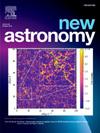Multi-point observation of a CME on August 16, 2020
IF 2.1
4区 物理与天体物理
Q2 ASTRONOMY & ASTROPHYSICS
引用次数: 0
Abstract
On August 16, 2020, at 17:12 UT, a long-duration B1.2-class flare erupted from a filament in the southeastern hemisphere, originating from an active region at S, E, near a large equatorial coronal hole (CH). According to LASCO coronagraph images from the L1 point, the associated CME erupted with a principal angle (PA) of approximately , close to the ecliptic plane, and at a speed of 437 km/s. Consequently, the Lorentz force between the CH’s magnetic field and the CME deflected the CME about northward. NOAA’s CME propagation models predicted a possible impact on Earth on August 19 around 22:00 UT. However, no signs of the CME were detected at Earth. Meanwhile, STEREO-A observed a disturbance in the solar wind around 19:00 UT, consistent with a CME impact. Considering that the magnetic field and solar wind plasma move together (i.e., under the frozen-in flux condition), and due to the Sun’s rotation, parcels of solar wind plasma spiral outward from the Sun (forming the Parker spiral). The solar wind spiral motion dragged the CME, deflecting it approximately eastward during its propagation to 1 AU, ultimately directing it toward STEREO-A’s location. Furthermore, remote-tracking observations from the two broadband visible-light refracting camera systems (HI-1 and HI-2) aboard STEREO-A captured the CME in J-plot images, tracking it from its eruption to its impact. Additionally, the bi-directional flow of suprathermal electrons observed by STEREO-A during the first 12 h of August 19, 2020, indicates that the CME crossed a high-speed stream (HSS) sector. An isotropic flux of suprathermal electrons observed around 19:00 UT further confirms the CME’s impact in STEREO-A’s vicinity.
2020年8月16日CME的多点观测
2020年8月16日,UT 17:12,东半球的一根灯丝爆发了一场持续时间很长的b2级耀斑,起源于32°S, 26°E的活跃区域,靠近一个大的赤道日冕洞(CH)。根据LASCO日冕仪从L1点拍摄的图像,相关CME喷发的主角(PA)约为99°,靠近黄道面,速度为437 km/s。因此,CH磁场和CME之间的洛伦兹力使CME向北偏转约30°。美国国家海洋和大气管理局的CME传播模型预测了8月19日22:00左右可能对地球产生的影响。然而,在地球上没有探测到CME的迹象。同时,STEREO-A在世界时19:00左右观测到太阳风的扰动,与CME撞击相一致。考虑到磁场和太阳风等离子体一起运动(即在通量冻结状态下),并且由于太阳的旋转,太阳风等离子体包裹从太阳向外旋转(形成帕克螺旋)。太阳风的螺旋运动拖着日冕物质抛射,在其传播到1天文单位的过程中向东偏转了大约30°,最终将其导向STEREO-A的位置。此外,STEREO-A上的两个宽带可见光折射相机系统(HI-1和HI-2)的远程跟踪观测以J-plot图像捕获了CME,跟踪了它从喷发到撞击的过程。此外,STEREO-A在2020年8月19日的前12小时观测到的超热电子双向流动表明,CME穿过了高速流(HSS)扇区。在世界时19:00左右观测到的超热电子的各向同性通量进一步证实了CME对STEREO-A附近的影响。
本文章由计算机程序翻译,如有差异,请以英文原文为准。
求助全文
约1分钟内获得全文
求助全文
来源期刊

New Astronomy
地学天文-天文与天体物理
CiteScore
4.00
自引率
10.00%
发文量
109
审稿时长
13.6 weeks
期刊介绍:
New Astronomy publishes articles in all fields of astronomy and astrophysics, with a particular focus on computational astronomy: mathematical and astronomy techniques and methodology, simulations, modelling and numerical results and computational techniques in instrumentation.
New Astronomy includes full length research articles and review articles. The journal covers solar, stellar, galactic and extragalactic astronomy and astrophysics. It reports on original research in all wavelength bands, ranging from radio to gamma-ray.
 求助内容:
求助内容: 应助结果提醒方式:
应助结果提醒方式:


